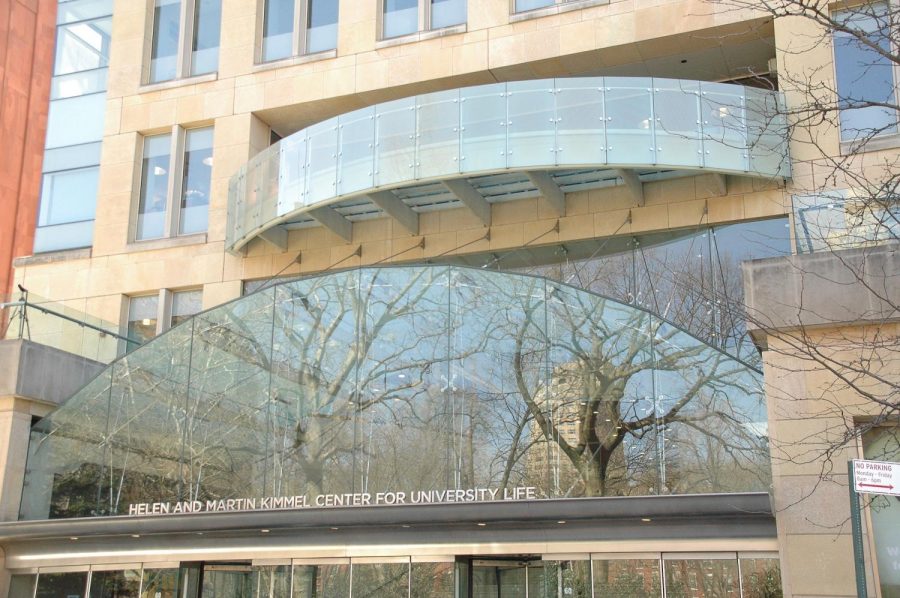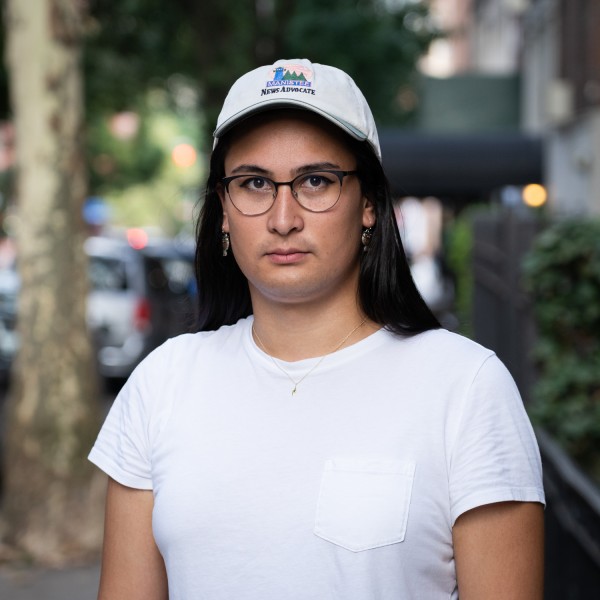Migrating birds imperiled by NYU buildings as spring approaches
Conservationists suggest steps that the university can take to keep birds from crashing into its windows.
The large windows in front of the Kimmel Center are a subtle hazard. NYU architecture is aggressively unfriendly to the birds in the city. (Staff Photo by Alex Tey)
March 29, 2021
As the spring migration season begins, birds traveling through New York City face the threat of reflective glass on NYU buildings. A Washington Square News review of crowdsourced data submitted to dBird.org and iNaturalist.org between 2015 and 2020 found 35 reports of dead or injured birds lying around buildings on NYU’s two New York City campuses, including five birds found dead below the windows of Bobst Library.
However, given the absence of organized monitoring efforts and the fact that most dead birds are disposed of by maintenance crews before passersby find them, these figures likely significantly underestimate the number of birds that have flown into NYU buildings.
Window collisions are one of the top threats to birds in North America. The bird population in North America has declined by 25% in the past 50 years, and according to the American Bird Conservancy, up to one billion birds die annually after colliding with window glass in the United States.
“Birds can’t see glass at all, period, end of story,” said bird mortality expert and consultant Heidi Trudell of Just Save Birds. “It’s either clear and completely invisible, or it’s a reflection and completely invisible.”
According to Trudell and NYC Audubon Senior Conservation Biologist Kaitlyn Parkins, the vast majority of collisions occur at the treeline level during morning foraging. Although NYU buildings are not “modern all-glass behemoths” like the most notorious bird-killing skyscrapers, Parkins said, even small windows are extremely deadly when they reflect foliage.
“In a lot of cases, what we see is reflective glass that’s reflecting habitat nearby,” Parkins said. “Birds perceive a reflected tree in glass as a real tree. So many birds hit that because it just perfectly reflects this tree, and it’s at the perfect height for them.”
NYU buildings, such as Bobst and the Kimmel Center for University Life, are particularly dangerous for birds because they reflect the tree canopies of Washington Square Park. Songbirds migrating at night and concentrating in the city — drawn in by the urban glow, dropping into the first greenery they find as dawn approaches — face the most risk.
In 2015, Parkins and her colleagues published the results of a study conducted at Bryant Park in midtown Manhattan finding that, on average, the carcasses of 63% of birds that die from glass collisions are never discovered, even when volunteers are actively searching for them.
When Viveca Morris was a graduate student at Yale University, she worked with maintenance staff and ornithologists at Yale’s natural history museum to document window collisions. Morris, who is now the director of an animal ethics program at Yale Law, said that the cooperation of facilities managers was invaluable to the collision monitoring efforts, since she and her colleagues relied on custodians to recover and record dead birds.
“I think that we’re lucky in that the facilities managers really, really do care about it,” Morris said.
David Alonso, vice president of NYU Facilities and Construction Management, did not respond to multiple requests for comment for this story. FCM Assistant Vice President Alfred Ng wrote in a November 2019 email exchange that the university does not track window collisions.
However, anyone can contribute reports of dead and injured birds to dBird.org — a project by the NYC Audubon Project Safe Flight team on which Parkins works — to help inform conservation efforts.
Georgia Silvera Seamans, an urban forester working in Washington Square Park and co-founding director of Washington Square Eco Projects, said she has received numerous reports from community members of birds colliding with windows at NYU-owned buildings in Silver Village and Washington Square Village.
“Some of those were found by kids just playing in the lawn area and coming across them,” Silvera Seamans said.
Of the NYU buildings facing Washington Square Park, Kimmel is especially reflective of the tree canopy — even more so than Bobst. According to Trudell, a few panels of fritted glass around the third-floor balcony are an example of relatively bird-safe glass. However, she said that the overall risk presented by Kimmel is still high because birds will likely avoid the fritted section and collide with other parts.
Regarding the current state of the building, “almost anything is better than what’s currently there,” Trudell wrote in an email to WSN.
The ideal solution, according to Trudell, would be to treat all the windows. The most cost-effective treatment solution, she said, is to retrofit dangerous windows around campus with products like SOLYX Bird Safety Film, Feather Friendly or CollidEscape, which are designed to make windows more opaque for birds, but still see-through for humans. Widely spaced stickers, another potential treatment, are largely ineffective at preventing collisions because birds try to fly between them.
“If there’s one cone in the road, you’ll go around it,” Trudell said, comparing the way birds see window stickers to the way humans see traffic cones. “We want to prevent birds from thinking that they can get between the markers that we place on the windows.”
On the other hand, birds see closely spaced window markers on clear or reflective glass as obstacles and avoid the windows. This not only slows the decline of bird populations, but also benefits people, Trudell added. Properly designed window stickers can mitigate glare, reduce incoming UV radiation, cut electricity costs by blocking solar heat and even offer aesthetic benefits.
“That really neat cut-out pattern would be fantastic,” Trudell said, regarding the facade of the Global Center for Academic and Spiritual Life. “Just cover the entire building and you wouldn’t have to worry about bird strikes at all.”
For now, as birds continue colliding with buildings, Trudell and Parkins said reporting collisions to platforms like dBird is the best way to contribute to efforts to make the city safer for birds.
“Identification really does not matter,” Trudell said, emphasizing that prior bird knowledge is not necessary to help document window collisions. “It’s just counting the bodies, documenting them, getting survivors to rehab.”
Only one such wildlife rehabilitation center exists in New York City — the Wild Bird Fund on the Upper West Side. Catherine Quayle, the WBF’s social media director, said that 1,200 of the 7,600 patients treated at the center in 2020 were window strike victims. During spring and fall migration, window strikes constitute 80% of their patients.
According to a map Quayle shared with WSN, about 10 window strike survivors were brought to the WBF from NYU’s New York City campuses through 2019.
The most important thing for a passer-by who sees an injured bird to do is to get it off the street, Quayle said. After moving them out of harm’s way, she recommended taking the bird to a wildlife rehabilitator like the WBF. According to Quayle, birds that survive window collisions often sustain severe injuries — such as concussions, eye damage or broken shoulders — that require professional treatment.
Proactively preventing such injuries and deaths, however, involves creating safer buildings. In addition to helping birds, Parkins suggested that NYU could benefit by putting up educational signage around retrofitted windows and publicizing their efforts toward protecting wildlife on campus.
“Retrofitting these windows will give you so much good press,” Parkins said. “You can be featured as a solution.”
A version of this article appeared in the Monday, March 29, 2021 E-print edition. Email Alex Tey at [email protected].
Correction: At the time of print, WSN wrote that Georgia Silvera Seamans was an ecologist. She is a forester. WSN regrets the error.

























































































































































